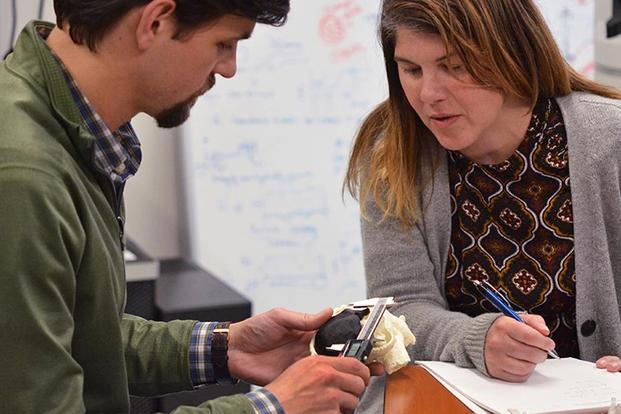
By Patricia Kime
A veteran at a VA medical center had been diagnosed with a tumor in his one remaining kidney. Facing possible dialysis for the rest of his life, the former service member was anxious about surgery and wondered whether he should risk removal of the mass.
Confused by the CT scans of his diseased organ, the veteran faced difficulty making a decision about the potentially life-altering procedure. But his VA surgeon had another option: the doctor loaded the medical imagery into a 3D printer, which used the information to build an exact replica of the patient’s kidney, tumor included. Using the model, the doctor could walk the veteran through the surgery, step-by-step. Then, once the veteran agreed to the surgery, the doctor followed the exact plan in the operating room.
“[3D printing] is a total game-changer,” said Dr. Beth Ripley, a radiologist at VA Medical Center Puget Sound and chair of the Veterans Health Administration’s 3D Printing Advisory Committee. “Often [technology] pushes us further away from our patients … this technology is allowing our VA staff to really come close to the patient.”
VA has launched an aggressive campaign to put 3D printers in many of its medical centers. The initiative aims to improve patient care by aiding surgical planning, crafting assistive medical devices and prosthetic limbs and eventually, creating bones and organs for transplant.
The department has more than 100 printers at 23 medical centers, up from just three in 2017. And it has plans to expand to even more, making it a leader in the effort to adapt 3D printing for medical use nationwide, where fewer than 100 academic and private health facilities — mainly at research universities — use 3D printing, according to Ripley.
“VA remains at the forefront of innovative work in 3D printing by expanding our expertise across VA,” Secretary Robert Wilkie said in a release. “Through this growing virtual network, VA continues to help define how 3D printing technology will be used broadly in medicine for the benefit of patients.”
While models may be the most obvious use for 3D printers, which create three-dimensional solid objects by layering various materials slice-by-slice, bottom-up, VA scientists are also looking to bioprinting — using the technology to create replacement tissues and organs — to treat diseases.
VA Ann Arbor Healthcare Systems in Michigan currently is working on creating an artificial lung that could be utilized while a patient waits for a lung transplant or needs help breathing during recovery from a respiratory illness.
The 3D artificial lungs would replicate the structure and size of the blood vessels and would be constructed of substances that would be more compatible with the human body, reducing immune response.
According to a VA release, the technology could eventually have long-term applications, such as providing replacement lungs. “This exciting project is the latest in a long string of incredible research and medical advancements developed by researchers over the years,” Wilkie said.
Other bioprinting initiatives at VA include creating vascularized bones. Ripley said that while the biologics printing is at least eight to 10 years away, VA plans to complete installation of the technology and train staff within the next two years; grow its ability to print prosthetics and other devices using advanced materials such as titanium in the next three to five years; and then, hopefully, be able to start implementing its development of human body parts within a decade.
The technology can also help occupational therapists build devices to improve veterans’ mobility and create orthotics that can be made and fitted in a day.
In one case, an occupational therapist at Hunter Holmes McGuire VA Medical Center in Richmond, Virginia, designed a specialized device that enabled a veteran to balance a pool cue at a billiards table, despite having lost an arm in combat.
“He was a world-class pool player … he could start to play pool again with just one hand. That is so cool,” Ripley said.
All this work is made possible, in part, through a partnership with GE Healthcare that provides software and work stations for the initiative while VA provides feedback on its medical needs and use of printers.
“We have a very comprehensive program that we are building throughout VA to make sure we are using 3D-printing technologies to the fullest,” Ripley said.
The VA’s 3D Printing Center of Excellence falls under what VA calls its VHA Innovation Ecosystem, which encompasses programs that aim to identify best practices at VA medical centers and push them out across the VA’s health system.
Ripley did not say how much the buildout of the printing network is costing VA, but she said printers, which come in seven different types, range from $3,000 for a basic printer that builds with simple plastics to $300,000 for one that can print with different colors and materials and up to $1 million for a titanium metal printer.
She said VA does not have a titanium printer — yet.
“Walter Reed [National Military Medical Center in Bethesda, Maryland] has titanium printers … and we talk with them. But we have [one] is in our three- to five-year plan, so stay tuned,” Ripley said.
She said for radiologists and physicians using the technology, it’s an exciting time to be at VA.
“This is happening through a specific program that encourages frontline staff to bring their best ideas forward … What you see with 3D printing is that the decision of what gets made is happening on the frontlines. These are people that are caring for patients every day, interacting with patients every day, seeing what they need. 3D printing allows them to become innovators at the bedside,” she said.





